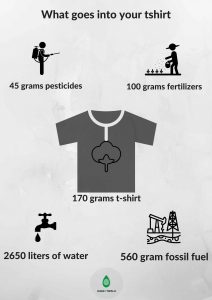FashionWala – The Fast Fashion Fiasco
How many times as kids did we experience the utter pleasure of buying new clothes on festivals and certain occasions in a year. Nowadays, the sense of satisfaction is driven not by the necessity of clothes but by perceived season sales established by fashion magnates. Most of the fashion world is being driven by senseless consumerism implicitly imposed by the smart marketing messages and humongous production capacities of the businesses in play and we, the common people, are bang in the middle of this reality.
Fashion is one of the biggest industries in the world which is now transitioning towards fast fashion. This means we are getting the established ‘latest’ trends as soon as possible. Majority of the garments bought are perceivably single use as the trends change quickly. This leads to an excessive consumption of clothes that the buyers may not need and moreover, adds to the already neck-breaking issue of excessive waste generation.
Throughout their lifecycle, garments require large quantities of fresh water, irrigation land, energy and chemicals. We usually overlook these hidden implications and rest our cases heavily on the visible factors. However, the question is how much do we know about the hidden costs of our choices?
After petroleum, textile industry is the second largest polluter. The clothes we wear can pollute the environment in a plethora of ways.

In Sweden, people use around 12.5 kilograms of textile per person per year that makes around 80 average sized t-shirts or 15 pairs of jeans, out of which two thirds is thrown away within the year. The United States of America, on the other hand, produces 30 kilograms of textile waste per person per year and the UK adds 1 million tons clothing in landfills each year. These thrown away clothes take around 200 years to biodegrade while the dyes pollute the landfill soils.
The polyester and nylon cloth are made from petrochemicals and are not biodegradable at all. It is estimated that 70 million barrels of oil are used just to produce virgin polyester required for the fabric demand each year. This manufacturing process uses great amounts of energy and emits greenhouse gases such as nitrous oxide that has the same adverse effect as 300 times that of carbon dioxide.
The textile produced with cotton grown non-organically contains large amounts of pesticides and fertilizers.

The dyeing process uses chemicals which finds their way into our rivers. China’s textile industry discharges about 2.5 trillion liters of wastewater into its rivers annually, according to a 2012 report from the non-profit Institute of Public & Environmental Affairs (IPE). Among these wastes are many hazardous chemicals that are banned or strictly regulated in other countries because they are toxic, persistent, bioaccumulative, hormone disruptive and can even cause cancer.
While most of the clothing is consumed in the US and Europe, more than 60 percent of world clothing is manufactured in developing countries. These clothing raw materials and finished goods are moved from one region to another in trucks and ships. While we don’t know the percentage of garments in shipping cargo, what we know is that a single cargo ships can emit as much cancer and asthma-causing pollutants as 50 million cars in just one year.

Coming closer to home, India is the second largest cotton producer in the world. Apart from the pollution challenges discussed above, the farmers’ health in India is of great concern.
According to the World Health Organization, upto 20,000 deaths are caused each year by pesticide poisoning in developing countries. The main reasons being lack of access to modern equipment and the resulting incapability to handle poisonous pesticides. Pesticide residue has been increasingly discovered in foods, farm animals and even breast milk.
Where do we go on from here on?
The most strategic approach to tackle this ecologically disruptive phenomena is to reduce our fast fashion intake! We can take a step towards buying less and not being gullible to false marketing messages.
When choosing garments, we can prefer natural fibres over synthetic ones as they are biodegradable. Organic cotton is way more sustainable. It uses less water, no fertilizers and pesticides so there is a considerably small environmental footprint. We can choose to purchase from organic brands and ditch the looming ghosts of unethical multinational fashion giants.

khadi charkha
‘Swadeshi’ means buying local products. This leads to cutting down on the pollution due to transport and promotes local culture and artisans. Khadi is the most sustainable textile available in India. It is hand spun, hand-woven natural fiber cloth from the mainly made out of wild cotton. It is sourced locally, involves rural employment, safe dyes and organic cotton.
There are exciting developments in the garment space where waterless dyeing is emerging as a viable option. Textiles made from recycled polyester is a greener as it requires less than half the original energy and helps keep the plastic out of landfills.
A cotton garment comfortably lasts within a range of 35 to 40 washes and many times we don’t use it for its whole life. Reusing cloth for other purposes is a great way forward. If 700 million people in India would reuse1 t-shirt, then the world would save 1.8 trillion litres of water! This is enough to provide water for the people of Delhi NCR for over 10 years!
We can also look at initiatives such as flea markets and free stores. These are co-operative ideas that are catching up quickly where people are gathering to share and exchange previously used clothes and giving their wardrobes a fresh yet sustainable makeover.
There are ample alternatives and many more are being developed. Eventually, it boils down to our collective will to make fashion more environmentally conscious.
At earth&us, It is our dream to empower consumers to make informed choices. We are working in this direction through an initiative called Impactwala. It enables you to access impact information in an easy and understandable manner which will ultimately lead to a greater societal shift!
May the ‘sustainable fashion’ force be with you!
Written by Allen Francis
Edited by Mohit Arora



